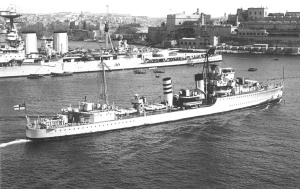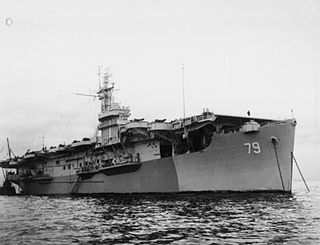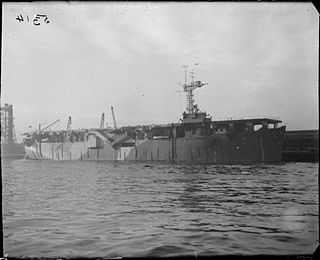The escort carrier or escort aircraft carrier, also called a "jeep carrier" or "baby flattop" in the United States Navy (USN) or "Woolworth Carrier" by the Royal Navy, was a small and slower type of aircraft carrier used by the Royal Navy, the Royal Canadian Navy, the United States Navy, the Imperial Japanese Navy and Imperial Japanese Army Air Force in World War II. They were typically half the length and a third the displacement of larger fleet carriers, more-lightly armed and armored, and carried fewer planes. Escort carriers were most often built upon a commercial ship hull, so they were cheaper and could be built quickly. This was their principal advantage as they could be completed in greater numbers as a stop-gap when fleet carriers were scarce. However, the lack of protection made escort carriers particularly vulnerable, and several were sunk with great loss of life. The light carrier was a similar concept to the escort carrier in most respects, but was fast enough to operate alongside fleet carriers.
The United States Navy, United States Coast Guard, and United States National Oceanic and Atmospheric Administration (NOAA) use a hull classification symbol to identify their ships by type and by individual ship within a type. The system is analogous to the pennant number system that the Royal Navy and other European and Commonwealth navies use.

The Royal Navy (RN) is the naval warfare force of the United Kingdom, British Overseas Territories and Crown Dependencies, and a component of His Majesty's Naval Service. Although warships were used by English and Scottish kings from the early medieval period, the first major maritime engagements were fought in the Hundred Years' War against France. The modern Royal Navy traces its origins to the English Navy of the early 16th century; the oldest of the UK's armed services, it is consequently known as the Senior Service.

The Battle of the Atlantic, the longest continuous military campaign in World War II, ran from 1939 to the defeat of Nazi Germany in 1945, covering a major part of the naval history of World War II. At its core was the Allied naval blockade of Germany, announced the day after the declaration of war, and Germany's subsequent counter-blockade. The campaign peaked from mid-1940 to the end of 1943.

A warship or combatant ship is a ship that is used for naval warfare. Usually they belong to the navy branch of the armed forces of a nation, though they have also been operated by individuals, cooperatives and corporations. As well as being armed, warships are designed to withstand damage and are typically faster and more maneuverable than merchant ships. Unlike a merchant ship, which carries cargo, a warship typically carries only weapons, ammunition and supplies for its crew.

HMS Battler (D18) was an American-built escort carrier that served with the Royal Navy during the Second World War.

HMS Chaser (D32/R306/A727) was an American-built Attacker-class escort carrier that served with the Royal Navy during the Second World War.

HMS Fencer (D64/R308) was an American-built Attacker-class escort carrier that served with the Royal Navy during the Second World War.

HMS Inglefield was an I-class destroyer leader built for the Royal Navy that served during World War II. She was the navy's last purpose-built flotilla leader. She was named after the 19th century Admiral Sir Edward Augustus Inglefield (1820–1894), and is so far the only warship to carry the name of that seafaring family. In May 1940, her pennant number was changed to I02.

HMS Biter was a Royal Navy escort carrier during the Second World War. She was laid down as a merchant ship at the Sun Shipbuilding & Drydock Company yard at Chester, Pennsylvania. Laid down on 28 December 1939, she was converted to an escort carrier and commissioned in the Royal Navy on 6 May 1942. She was returned to the United States in 1945 and subsequently lent to France.

HMS Kite (U87) was a Modified Black Swan-class sloop of the Royal Navy, once commanded by the famous U-boat hunter Captain Frederic John Walker. She was one of several ships of that class that took part in the famous "six in one trip" in 1944.

The Ruler class of escort aircraft carriers served with the Royal Navy during the Second World War. All twenty-three ships were built by the Seattle-Tacoma Shipbuilding Corporation in the United States as Bogue-class escort carriers, supplied under Lend-Lease to the United Kingdom. They were the most numerous single class of aircraft carriers in service with the Royal Navy.

The Attacker class were a class of escort aircraft carriers in service with the British Royal Navy during the Second World War.

HMS Avenger was a Royal Navy escort aircraft carrier during the Second World War. In 1939 she was laid down as the merchant ship Rio-Hudson at the Sun Shipbuilding & Drydock Company yard in Chester, Pennsylvania. Launched on 27 November 1940, she was converted to an escort carrier and transferred under the lend lease agreement to the Royal Navy. She was commissioned on 2 March 1942.

HMS Nairana was the lead ship of the Royal Navy's Nairana-class escort carriers that saw service in the Second World War. She was built at John Brown & Company shipyards in Clydebank, Scotland. When construction started in 1941 she was intended as a merchant ship, but was completed and launched as an escort carrier, entering service at the end of 1943.

HMS Vindex (D15) was a Nairana-class escort carrier of the Royal Navy that saw service during the Second World War. She was built at Swan Hunter shipyards in Newcastle upon Tyne. When construction started in 1942 she was intended as a merchant ship, but was completed and launched as an escort carrier, entering service at the end of 1943.

The Nairana-class escort carrier was a British-built class of three escort carriers. They were constructed one each in England, Scotland and Northern Ireland to the same basic design during the Second World War for service with the Royal Navy.

An amphibious assault ship is a type of warship employed to land and support ground forces on enemy territory during an armed conflict. The design evolved from aircraft carriers converted for use as helicopter carriers. Modern designs support amphibious landing craft, with most designs including a well deck. Like the aircraft carriers they were developed from, some amphibious assault ships also support V/STOL fixed-wing aircraft and have a secondary role as aircraft carriers.
Archer is the name of various ships:
World War II was the first war where naval aviation took a major part in the hostilities. Aircraft carriers were used from the start of the war in Europe looking for German merchant raiders and escorting convoys. Offensive operations began with the Norwegian campaign where British carriers supported the fighting on land.














